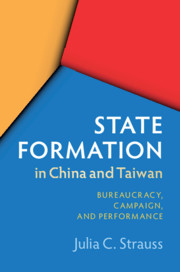Book contents
- State Formation in China and Taiwan
- State Formation in China and Taiwan
- Copyright page
- Dedication
- Contents
- Figures
- Acknowledgments
- Introduction
- 1 Virtue and Talent in Making Chinese States
- 2 Comparative Terror in Regime Consolidation
- 3 Performing Terror
- 4 Repertoires of Land Reform Campaigns in Sunan and Taiwan, 1950–1954
- 5 Theaters of Land Reform
- Conclusion
- Book part
- Documentary Collections, Reports, and Periodicals
- Bibliography
- Index
- References
Bibliography
Published online by Cambridge University Press: 13 October 2019
- State Formation in China and Taiwan
- State Formation in China and Taiwan
- Copyright page
- Dedication
- Contents
- Figures
- Acknowledgments
- Introduction
- 1 Virtue and Talent in Making Chinese States
- 2 Comparative Terror in Regime Consolidation
- 3 Performing Terror
- 4 Repertoires of Land Reform Campaigns in Sunan and Taiwan, 1950–1954
- 5 Theaters of Land Reform
- Conclusion
- Book part
- Documentary Collections, Reports, and Periodicals
- Bibliography
- Index
- References
- Type
- Chapter
- Information
- State Formation in China and TaiwanBureaucracy, Campaign, and Performance, pp. 265 - 274Publisher: Cambridge University PressPrint publication year: 2019
References
Bibliography
Works in Chinese



